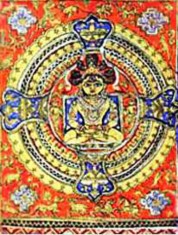11.2 Western Indian School of Painting

WesternIndianpainting,alsocalledJainaPainting,ahighlyconservativestyleofIndianminiaturepainti nglargely devoted to the illustration of Jaina religious texts of the 12th–16th century. Though examples of the school are most numerous from Gujarāt state, paintings in Western Indian style have also been found in Uttar Pradesh and central India. In Orissa on the east coast, the style has persisted almost to the present.
The school is characterized by simple, bright colours, highly conventionalized figures, and wiry, angular drawing. The naturalism of early Indian wall painting is entirely absent.
The earliest manuscripts are on palm leaves, and the same oblong format (about 12 by 4 inches [30 by 10 cm]) was continued even after paper began to be used toward the end of the 14th century. The style, fairly well established by the end of the 13th century, changed little over the next 250 years. Figures are shown for the most part from a frontal view, with the head in profile. The facial type, with its pointed nose, is related to that seen in wall paintings at Ellora
(mid-8th century) and is remarkably close to medieval sculpture. A striking convention is the projecting “further eye,” which extends beyond the outline of the face in profile.
